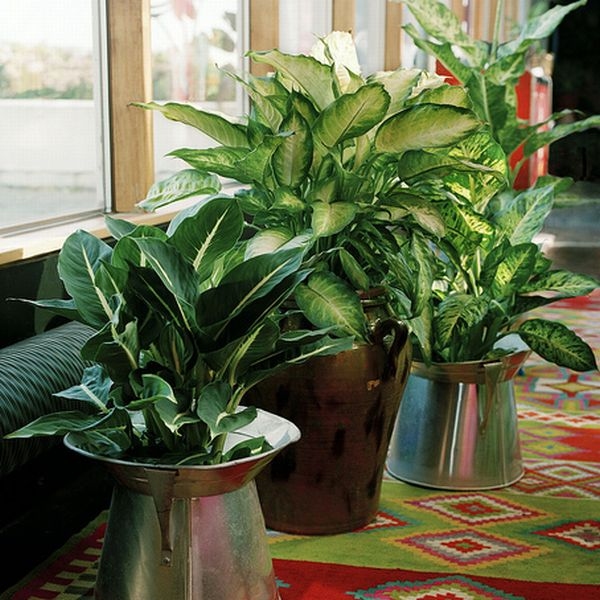 The old gardener's rule, that the casting- and spray water should have the same temperature as the air, also applies to our indoor plants. It is based on observation, that all parts of the plant show the same warming as the surrounding air. In the case of indoor plants in pots, the soil, which is surrounded by air on all sides, is approximately adapted to the room temperature. So cold water could have a shock effect on the wetted parts of the plant. This is how the reasoning comes about, that it would be detrimental, Watering or spraying over plants that are standing in cold rooms with warmer water! Our cultivated plants also make special demands on certain reaction conditions in the soil, with the optimum for the growth of the individual plant species at alkaline, neutral or acidic reaction. When it comes to indoor plants, we can, to meet the special demands on the soil reaction by using appropriate types of soil. The measure of the reaction (d.h. for the concentration of free hydrogen ions in aqueous solutions) is the pH. He indicates, whether a solution is acidic, is alkaline or neutral. The neutral point is determined by pH 7 marked; values below indicate acidic, alkaline reaction above.
The old gardener's rule, that the casting- and spray water should have the same temperature as the air, also applies to our indoor plants. It is based on observation, that all parts of the plant show the same warming as the surrounding air. In the case of indoor plants in pots, the soil, which is surrounded by air on all sides, is approximately adapted to the room temperature. So cold water could have a shock effect on the wetted parts of the plant. This is how the reasoning comes about, that it would be detrimental, Watering or spraying over plants that are standing in cold rooms with warmer water! Our cultivated plants also make special demands on certain reaction conditions in the soil, with the optimum for the growth of the individual plant species at alkaline, neutral or acidic reaction. When it comes to indoor plants, we can, to meet the special demands on the soil reaction by using appropriate types of soil. The measure of the reaction (d.h. for the concentration of free hydrogen ions in aqueous solutions) is the pH. He indicates, whether a solution is acidic, is alkaline or neutral. The neutral point is determined by pH 7 marked; values below indicate acidic, alkaline reaction above.
The optimal values for our indoor plants are often very specific. So claim z. B. Azaleas (Rhododendron simsii Planch.) a pH range of 3.5-4.5, Gloxinien (Sinningia speciösa (Lottery.) Here.) of pH 5,0-6,5 and cinerariums (He was bleeding in old age (L'Herit.) DC.) von 6,6-7,5.
For plant growth – specifically for absorbing the mineral nutrients – the pH value of the aqueous fertilizer solution is of great importance. The reaction conditions of the soil in the pots are also largely influenced by the pH value of the water used for watering. For the majority of our indoor plants, the pH range of the irrigation water is between pH 5 and pH 6 the cheapest. Since higher pH values of the water usually run parallel to higher degrees of hardness, the degree of hardness of the irrigation water must also be taken into account. Water hardness is measured in °dH (= degree of German hardness) specified, whereby 1 °dH the content of 10 mg CaO (calcium oxide) pro 1 liters of water means. Soft water has 4-8 °dH, medium hard 8-12 °dH, pretty hard 12-18 °dH and very hard over 30 °dH. The soft and medium-hard water can be safely used as irrigation water for our indoor plants. Azaleas are an exception, hydrangeas, Of camels, Bromelien u. a. plant species, which require a very acidic soil reaction. For them, the use of water with more than 10 ° dH (by shifting the required acidic reaction of the cultured soil to the neutral side) to growth disorders. Therefore, we either have to collect rainwater for watering the plants or - if this is not possible - – boil the tap water and let it stand, so that the lime- and settle magnesium salts. These salts form the "temporary" (= temporary) hardness, those at temperatures above + 40 °C disappears again. The permanent hardness, those caused by sulfates, Chlorides and nitrate compounds are formed, can only be softened with a technical device (with. B. the permutite process used in horticulture) or eliminated by adding oxalic acid. However, this is generally too cumbersome for indoor gardening. But such water softening can, especially for valuable bromeliads- and also orchid stocks in plant windows and showcases are necessary.
In the poor in light, cool months, when the plants are more or less forced to remain dormant and their need for moisture is low, watering must be done very carefully. In the warm season on the other hand, when the plants are in full growth, is an even, plentiful water supply is essential. The "art of plant care" consists mainly in this, to keep the water requirement and consumption of the plants in line with the water supply, especially during the time when growth is unfavorable, and to supply the indoor plants with water of a "quality"., their special need for hardness- and acidity corresponds. The water quality is of particular importance when producing the nutrient solutions for the soilless culture.
